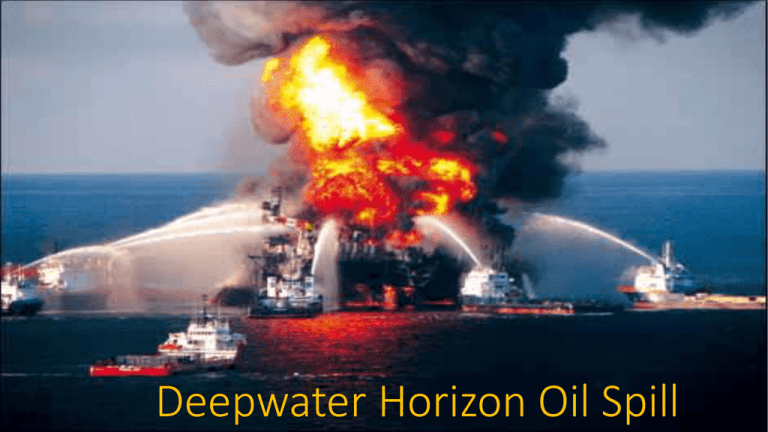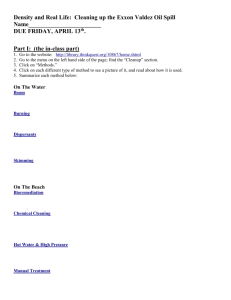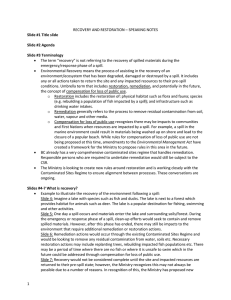Deepwater Horizon Oil Spill
advertisement

Deepwater Horizon Oil Spill Quick Facts • Occurred April 20th, 2010, 50 miles off coast of Louisiana • Drilled in 5,100 feet of water to a depth of 35,000 feet • Released approximately 4.9 million barrels of oil (210 million gallons) • Settled criminal charges with DOJ including 11 counts manslaughter, and 1 felony count of lying to Congress ($4.525 billion settlement. • Oil being cleaned up with booms, dispersants, and oil-eating microbes • www.youtube.com/watch?v=B08p7zltm1w Which Laws Govern? • Oil Pollution Act of 1990 • National Environmental Policy Act • Clean Water Act Oil Pollution Act of 1990 (“OPA 90”) • Passed by Congress following Exxon Valdez oil spill in 1989 • Amended Section 311 of the Clean Water Act to govern oil • Consolidates federal environmental statutes, such as Endangered Species Act, Migratory Bird Treaty Act, Refuse Act, etc. • $75 million liability ceiling unless gross negligence or willful misconduct (waived by BP) • Creates Oil Spill Trustee Council • Addresses natural resource damages through NRDA National Environmental Policy Act • Followed a blowout at Union Pacific Oil Platform off Coast of Santa Barbara, California • Established the Council on Environmental Quality in the Executive Office of the President • Sets forth environmental reviews and requires impact statements for actions taken by the federal government (including cleanup) Clean Water Act • Prohibits discharge of pollutants into navigable waters of United States • Being used by Justice Department to sue BP civilly • Penalties of Administered by DHS/EPA • Penalties: $37,500 per day of violation or $1,100 per barrel of oil • Gross negligence: $140,000 per day of violation or $4,300 per barrel Who Is In Charge? • OPA 90 Trustee Council • Department of Homeland Security • Environmental Protection Agency • National Oceanic and Atmospheric Administration OPA 90 Trustee Council • Serves as a legal group of trustees, including federal, state and tribal representatives • Trustees typically chosen by the governors of the affected states • Administers National Resources Damage Assessment Alexander, Kristina. The 2010 Oil Spill: Natural Resource Damage Assessment Under the Oil Pollution Act. Rep. no. R41396. Washington D.C.: Congressional Research Service, 2010. Department of Homeland Security • National Incident Commander named after Title 40 “Spill of National Significance” • Most actions taken through the U.S. Coast Guard • Considered an interest of national security • Directed National Response Teams pursuant to Clean Water Act Environmental Protection Agency • Responsible for cleanup of oil that lands on the coast • Collects land-based samples and monitors marshes and wetlands • Is administering the NEPA environmental impact statements National Oceanic and Atmospheric Administration • Collects scientific data in the form of water sampling, satellite imagery and animal death statistics • Has cooperative authority along with USCG • Responsible for monitoring the leaking of oil after well capped How Is Damage Calculated? OPA 90’s NRDA Process: • Preassessment Phase • Restoration Planning Phase • Restoration Implementation Phase Preassessment Phase • Involves establishment of jurisdictional areas of the Trustee Council • Notification of responsible parties • Gathers information regarding injuries to environment and persons • Collects scientific data from cooperating agencies Restoration Planning Phase • Currently being applied • Calls for Public Notice and Comment • Calls for injury assessment and developing restoration alternatives Restoration Implementation Phase • Administrative record closed • Present a demand to responsible parties • Responsible parties respond within 90 days • Responsible parties must agree or sue • May establish future committees to oversee long-term monitoring Source: The International Tanker Owners Pollution Federation Limited. Fate of Marine Oil Spills. Tech. no. 2. London: International Tanker Owners Pollution Federation Limited, 2002. Print. How Is BP’s Liability Limited? • Can sue owner of the rig (Transocean) for indemnification • Insurance for blowout and some costs of cleanup • Not eligible for tax deductions The End




